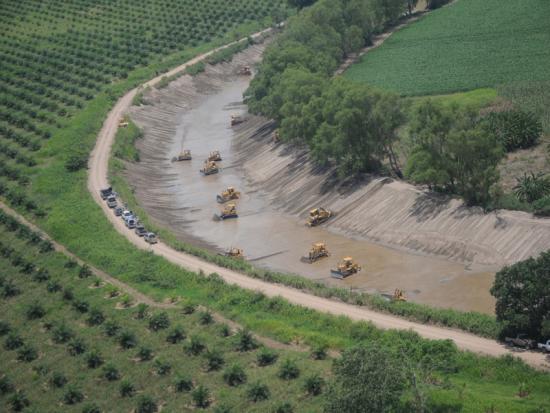Reading the “Land Grab” and “Combatting Monsanto” reports by La Via Campesina shows that the issues of land, debt and food are intimately interwoven. Speculative capital has moved into land, food and climate change offsets as a new market since the collapse of debt-based securities in 2008. The global land-grab now underway is enabled in part by getting peasant farmers so into debt that their only option is to sell or self-kill.
I’ve discussed how the dramatic expansion of the Commodities Futures Index after the 2008 crash led to an inflation of food prices. In turn, many believe that the Arab Spring received a decisive impetus from this deterioration of living standards among the poorest. The land, debt and food crisis may–indeed, should–provide another turn of that screw.
Land grabbing resembles both colonization and the formation of plantations. What’s new is both the scale of the preset movement and the multinational origin of the speculators. A 2012 report by The Land Matrix shows that since 2008, some 82 million hectares of land–1.7% of the world’s agricultural space– have been “granted” or otherwise obtained in developing countries by such enterprises. Data and ownership trails are difficult to establish, it should be noted, so some estimates are much higher.
La Via Campesina rejects all these legal niceties and calls them all land grabs. Governments and multinational corporations are involved, including nations from the global South like the West African Economic and Monetary Union. There are cases like Mauritius, trying to secure land in the event that sea-level rise renders their nation uninhabitable:
Therefore it is not always a question of countries of the North buying land from countries of the South. However, it is always a question of industrial agriculture replacing sustainable family farming.
For example, in the Honduran region of Bajo Aguán, peasants were compelled to grow palm oil for biofuels and then found their land subject to enclosure by the leading landowners in what is called “land counter-reform.” There are widespread reports of human rights abuses, including fifty deaths.
In Asia, debt is the primary weapon against landowners. As public services are privatized, peasants and family farmers are compeled to borrow to pay water and electricity bills, or even health care. Micro-credit provided by institutions such as the Banque de promotion agricole in Laos have no provision for crop failure or other accident. Money lenders move in, and soon the land is lost. In India, the epidemic of farmer suicide is so intense, it’s almost hard to believe: over a quarter of a million farmers have self-killed, often by consuming the pesticides given to them for use with the Bt cotton (designed to be resistant to pesticide for bollworm). Official figures underreport, not least because women are not considered to be farmers.
Ironically, land is being taken from peasant and indigenous farmers in the name of climate change mitigation. In Indonesia, Thailand, Cambodia and India, forest is being assigned as REDD (Reducing Emission from Deforestation and Forest Degradation).
In Africa, subject to the worst of all these practices, there are 80 million small-scale farmers most of whom are women. Land grabs are also seen in Europe, particularly in Eastern Europe and the former Soviet Union.
Programs to defend small-scale farming have been defeated by “developed” nation resistance, such as the 2006 Declaration of the International Conference on Agrarian Reform. The World Bank’s “Responsible Agricultural Investment” program is a charade in which legal titles are invented for land that was never held in that fashion and then “sold” or transferred to multinationals.
Several important considerations arise from the report, as Jun Borras notes in his conclusion:
- climate-change mitigation, biofuels and food needs are being used to justify the land grab
- Traditional imperial centres are involved but so are the BRIC nations and even middle income countries creating a “polycentric agro-feed-fuel regime.”
- Given this polycentrism, four movements need to work together: agrarian justice, environmental justice, labor and food movements.
We certainly need a new geo-imaginary adequate to this. More than that, even, we need a new democracy. I think that only direct democracy can (or might be able to) solve this kind of intense nexus of activist interest, political power and financial speculation. NGOs, the UN and the nation states have all tried and failed. Ironically, it may only be the prospect of major financial collapse, such as that now emerging from Europe, that gives us the opportunity. We need to be ready.


A quarter of a million driven to suicide in India alone, at a very conservative estimate.
Surely the land-grab activities described in this article should be regarded in the same light as slave trading and war crimes, and all who care about human rights should so declare.
Every contract, law, treaty, or constitution that attempts in any way to justify or vindicate such land grabs only destroys any moral authority it might otherwise have had. All those who aid these activities are criminal accomplices, including judges and other government officials who are required by law to act as they do. Legal authority for land grabs should not be regarded as a justification or mitigation of any sort, but rather as an aggravating factor, compounding the perpetrator’s original offense with the further offense of acting under color of authority. No form of law has the power to transcend the fundamentals of human rights.